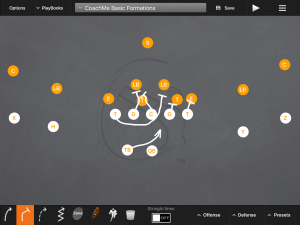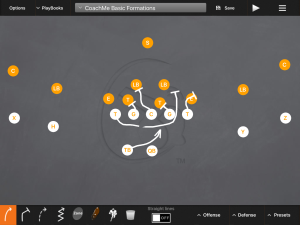Baylor’s record breaking Rushing Game against North Carolina
One of the big stories of College Bowl Season was the dominating performance by the Baylor Bears ground game against North Carolina. Baylor famously played the entire game without a true QB (due to injuries). They used a collection of different RBs and WRs taking direct snaps in route to the most dominating ground performance in Bowl game history.
The major components of the Baylor ground attack were Inside Zone (IZ), Iso/Lead, Counter, 1 Back Power, Dart, and Jet. The majority of this post is going to focus on their “Dart” Scheme.
DART
Dart combines elements of a man scheme and a gap scheme. The playside is blocked similar to “1 back power” but the backside tackle pulls to wrap through the first open hole playside. By pulling the tackle rather than the guard, it allows the OL to use the C and backside guard (BSG) to combo up to Will LB. The backside End is left alone. The play is designed to work against a 6 man box and UNC gave Baylor favorable box numbers all game long (5 and 6 man boxes).
Below are two diagrams of the play. Note that the playside guard will either down block the 1 tech, or base block the 3 tech out… it just depends on the alignment of the DT on his side.


Against a 3 man front the guard would combo with the nose. It would be tough to play a 5 man front against a spread offense but if it happened you would need to man up with the playside OL and still pull BST through the first open gap he can up to playside LB.
Baylor ran this concept with the RB and QB (wildcat guy) over a dozen times. Below I will breakdown several of the variations they used. These are just a few examples of the many times they ran Dart. What I love is the little variations/wrinkles they threw in, but the play stays the same for the OL up front.
Dart 1
Dart 2 (with H back motion out)
Dart 3 (with a TE backside) Here is an example against a 5-2 look. By having the TE run up the seam it occupies the DE briefly, and the LB carries here vertically which takes him completely out of the play.
Dart 4 (from empty)
Dart 5 (TE backside again)
Dart 6 & 7 (Ran it back to back plays with tempo)
Dart 8 (H back motion across to empty) includes skyCam angle
QB Counter
Baylor also ran a QB counter scheme that timed up similar to a draw. In this scheme they would use the BSG to kick or log the DE like usual but would hinge backside with the BST. Their 2nd puller, or “wrapper” was the RB.
In all 3 of the examples below you will see the play side DE squeeze the down block and wrong arm the guard. This forces the BSG to log him and seal him inside. This is a clear read for the RB to get around him to pick up the LB. The QB now just needs to give the RB enough time to get ahead of him, and cut off of the block the RB makes on the LB.
QB Counter 1
QB Counter 2
QB Counter 3 (Great End Zone Shot)
Jet Sweep
The last series Baylor used that I want to discuss is their Jet Sweep series. For any one unfamiliar with Jet Sweep, it involves bringing a WR in full speed motion to run a sweep to the edge. Typically a team will use outside zone or reach blocking to try to run around defenders, sealing them inside. Baylor does some interesting things with Jet Motion, and for a team with no real threat to throw at this point, Jet sweep becomes a great way to get the ball in the hands of your playmaking WRs. Baylor uses some unique formations to set up the Jet Sweep. They will often run Jet from an unbalanced formation or cover up WRs. This allows them to get an extra blocker outside or an extra OL playside working to reach defenders. It is also common for Baylor to use a TE/H back aligned just outside of their end man to help seal the edge and lead up on an OLB. Perhaps the most interesting thing about their Jet Sweep package, is that they DO NOT hand the ball off to their jet motion man. The QB will do a quick touch throw/flip forward. The benefit of this quick flip is it technically makes the sweep a “forward pass”. This gives Baylor some built in protection in case the mesh is mishandled, it will be called an incomplete pass, rather than a fumble and a potential turnover (you will see why soon).
Below are 2 examples of the Jet Sweep. North Carolina’s defense does an excellent job of fighting the reach blocks and not giving the jet sweep player an easy lane to the outside. They are able to stop these 2 attempts without letting them develop into long runs. Their defense flows incredibly fast to the football.
Jet 1
Jet 2
Here is an example of why doing Jet as a “forward pass” has merit. The toss is bobbled, but because it was forward, it is ruled an incomplete pass, Baylor loses a down but they do not lose any yards or the football.
Jet Keep
Noticing North Carolina’s fast flow to stop the Jet Sweep before it gets started Baylor had some success with the QB keeping it on the backside. This can either be a true read on the backside DE, or it can be called by the coach from seeing the defensive reaction from the pressbox or sideline.
Jet QB Keep 1
Jet QB Keep 2 (80 yard TD run)
Conclusion
The Dart, QB Counter, and Jet Series were certainly not Baylor’s only reasons for offensive success against North Carolina. Inside Zone, Iso/Lead, 1 back power, and a few completed passes were critical to their success throughout the game. I thought these plays were unique and deserved to be highlighted here.
In total Baylor tallied
756 total yards, 645 of which came on the ground
![]()
